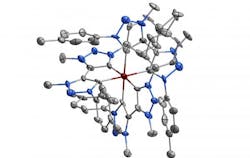Modern alchemy allows iron molecules to emit orange light
As described in an article in Nature, researchers at Lund University (Lund, Sweden) have made the first iron-based molecule capable of emitting light. This could contribute to the development of affordable and environmentally friendly materials for solar cells, light sources, and displays.
RELATED ARTICLE: LLNL and LLE researchers compress iron to 560 GPa with laser multishock compression
For more than 50 years, chemists have developed metal-based dye molecules for a wide range of different applications, such as displays and solar cells. This would ideally involve common and environmentally friendly metals like iron, but despite a number of attempts no one has been able to develop an iron-based dye molecule that can emit light until now. Researchers around the world have instead largely relied on various rare and precious metals, such as ruthenium, which have more easily provided the desired properties.
Through advanced molecular design, the Lund researchers have now successfully manipulated the electronic properties of iron-based molecules so that they much better resemble the ruthenium-based substances. By doing so, they have, for the first time, created an iron-based dye molecule that is not only able to capture light, but also to emit light of a different color. The latter is significantly more difficult to achieve, which contributes to why the researchers' accomplishment in showing that the new iron molecule emits orange light is so important.
"Medieval alchemists tried to produce gold from other substances, but failed. You could say that we have succeeded in performing modern alchemy by giving the iron properties which resemble those of ruthenium,” says Kenneth Wärnmark, professor of Chemistry at the Faculty of Science at Lund University.
The new study describes an iron complex with a record-breaking life span in its light-absorbing and luminescent state: 100 ps. But despite the seemingly inconceivably short time interval, it is quite sufficient. "In the world of chemistry, this is enough time for the molecules to emit light," says Villy Sundström, professor of Chemistry at Lund University.
"We expect that the next step to develop the actual molecules that are suitable for commercial applications could take another five years," says Petter Persson, chemistry researcher at Lund University. In addition to the researchers from Lund, the study has included researchers from the Ångström Laboratory in Uppsala and from Copenhagen.
SOURCE: Lund University; http://www.lunduniversity.lu.se/article/modern-alchemy-creates-luminescent-iron-molecules
About the Author

Gail Overton
Senior Editor (2004-2020)
Gail has more than 30 years of engineering, marketing, product management, and editorial experience in the photonics and optical communications industry. Before joining the staff at Laser Focus World in 2004, she held many product management and product marketing roles in the fiber-optics industry, most notably at Hughes (El Segundo, CA), GTE Labs (Waltham, MA), Corning (Corning, NY), Photon Kinetics (Beaverton, OR), and Newport Corporation (Irvine, CA). During her marketing career, Gail published articles in WDM Solutions and Sensors magazine and traveled internationally to conduct product and sales training. Gail received her BS degree in physics, with an emphasis in optics, from San Diego State University in San Diego, CA in May 1986.
